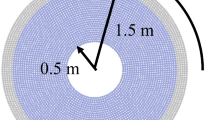Abstract
In this study, high-vacuum flow was analyzed using the direct simulation Monte Carlo (DSMC) method, and various forces acting on fine particles in a high-vacuum flow field were studied. The DSMC method is a Lagrangian method that models the flow as particles and analyzes the collisions and behaviors of each particle, which costs a large computing resource. To validate DSMC method, computational results of a Poiseuille flow in microchannel are compared with analytical results. In addition, the force acting on the particles in the high-vacuum rarefied gas region was verified using the outputs of previous studies. Through this numerical analysis, it is possible to analyze about regions that are difficult to proceed with experiments. As a result, the drag forces according to the Knudsen number which indicates the ratio of vacuum and the particle size, it was confirmed that the drag force can be predicted through the empirical formula of previous studies.
Similar content being viewed by others
References
G. A. Bird, Molecular Gas Dynamics and the Direct Simulation of Gas Flows, Clarendon Press, Oxford (1994).
S. Chapman and T. G. Cowling, The Mathematical Theory of Non-uniform Gases, an Account of the Kinetic Theory of Viscosity, Thermal Conduction and Diffusion of Gases, Cambridge University Press, Cambridge (1952).
G. A. Bird, Direct simulation and the Boltzmann equation, Physics of Fluids, 13 (11) (1970) 2676.
G. Russo, Plane Couette flow computations by TRMC and MFS methods, AIP Conference Proceedings, 762 (2005) 577.
E. P. Muntz, Rarefied gas dynamics, Annu. Rev. Fluid Mech., 21 (1989) 387–417.
T. Ozawa et al., Particle and continuum method comparison of a high-altitude, extreme-Mach-number reentry flow, Journal of Thermophysics and Heat Transfer, 24 (2) (2010) 225–240.
I. Sohn et al., Coupled DSMC-PMC radiation simulations of a hypersonic reentry, Journal of Thermophysics and Heat Transfer, 26 (1) (2012) 22–35.
G. A. Bird, The velocity distribution function within a shock wave, Journal of Fluid Mechanics, 30 (3) (1967) 479–487.
G. A. Bird, The structure of normal shock waves in a binary gas mixture, Journal of Fluid Mechanics, 31 (4) (1968) 657–668.
G. A. Bird, Aspects of the structure of strong shock waves, Physics of Fluids, 13 (5) (1970) 1172.
G. A. Bird, The structure of rarefied gas flows past simple aerodynamic shapes, Journal of Fluid Mechanics, 36 (3) (1969) 571.
K. Swaminathan-Gopalan and K. A. Stephani, Recommended direct simulation Monte Carlo collision model parameters for modeling ionized air transport processes, Physics of Fluids, 28 (2) (2016) 027101.
G. A. Bird, Direct molecular simulation of a dissociating diatomic gas, Journal of Computational Physics, 25 (4) (1977) 353–365.
T. Ozawa, J. Zhong and D. A. Levin, Development of kinetic-based energy exchange models for noncontinuum, ionized hypersonic flows, Physics of Fluids, 20 (4) (2008) 046102.
Z. Li et al., Modeling of electronic excitation and radiation in non-continuum hypersonic reentry flows, Physics of Fluids, 23 (6) (2011) 066102.
T. E. Schwartzentruber and I. D. Boyd, A hybrid particle-continuum method applied to shock waves, Journal of Computational Physics, 215 (2) (2006) 402–416.
H. Burau et al., PIConGPU: a fully relativistic particle-in-cell code for a GPU cluster, IEEE Transactions on Plasma Science, 38 (10) (2010) 2831–2839.
I. Sohn et al., Efficiency enhancement of PIC-MCC modeling for magnetron sputtering simulations using GPU parallelization, IEEE Transactions on Plasma Science, 44 (9) (2016) 1823–1833.
E. A. Malkov and M. S. Ivanov, Parallelization of algorithms for solving the Boltzmann equation for GPU-based computations, AIP Conference Proceedings, 1333 (2011) 946.
C. Emma, On the velocity of steady fall of spherical particles through fluid medium, Proceedings of the Royal Society A: Mathematical, Physical and Engineering Sciences, 83 (563) (1910) 357–365.
R. A. Millikan, The isolation of an ion, a precision measurement of its charge, and the correction of stokes’s law, Science, 32 (822) (1910) 436–448.
M. Knudsen and S. Weber, Luftwiderstand gegen die langsame bewegung kleiner kugeln, Annalen der Physik, 341 (15) (1911) 981–994.
R. A. Millikan, The general law of fall of a small spherical body through a gas, and its bearing upon the nature of molecular reflection from surfaces, Physical Review, 22 (1) (1923) 1–23.
R. T. Birge, The 1944 values of certain atomic constants with particular reference to the electronic charge, American Journal of Physics, 13 (2) (1945) 63–73.
J. H. Kim et al., Slip correction measurements of certified PSL nanoparticles using a nanometer differential mobility analyzer (nano-DMA) for Knudsen number from 05 to 83, Journal of Research of the National Institute of Standards and Technology, 110 (1) (2005) 31.
E. S. Piekos and K. S. Breuer, Numerical modeling of micromechanical devices using the direct simulation Monte Carlo method, Journal of Fluids Engineering, 118 (3) (1996) 464–469.
Author information
Authors and Affiliations
Corresponding author
Additional information
Sang-Hwan Lee received his Ph.D. from State University of New York at Buffalo in 1986. Now he is a Professor of Mechanical Engineering Department at Hanyang university. Recently his research interest is particle simulation, computational fluid dynamics and desalination simulation which are based on GPU computing and parallel computing.
Rights and permissions
About this article
Cite this article
Shin, S.W., Lee, S.H. Numerical simulations of nano-particle’s drag forces using DSMC method for various Knudsen numbers. J Mech Sci Technol 36, 4649–4657 (2022). https://doi.org/10.1007/s12206-022-0826-y
Received:
Revised:
Accepted:
Published:
Issue Date:
DOI: https://doi.org/10.1007/s12206-022-0826-y




